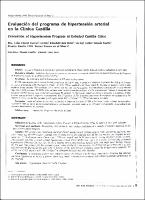Evaluación del programa de hipertensión arterial en la Clínica Castilla
Date
2000-12Author(s)
Chávez García, Lidia
Jara Brito, Elizabeth
Estrada Surita, Esther
Instituto Peruano de Seguridad Social
Metadata
Show full item recordAlternate title
Evaluation of Hypertension Program at EsSalud Castilla Clinic
Abstract
Objetivo. Evaluar el Programa de Control de Hipertensión Arterial de la Clínica Castilla, EsSalud, mediante indicadores de corto plazo.
Material y Métodos. Evaluación descriptiva, transversal, no aleatoria de una muestra representativa de pacientes hipertensos del Programa de Hipertensión Arterial de la Clínica Castilla, EsSalud.
Resultados. Se entrevistó y revisó la historia clínica de 807 pacientes del programa.
El 55% eran mujeres y 45% varones; la edad promedio fue 66.7 ± 9.4 años; el tiempo en el programa en promedio fue 28.8 ± ll 0 meses. Al ingreso al programa el 18.7% estaba en estadio I de HTA, 57% en estadio II y 24.3% en estadio III. Durante los últimos 6 meses o más, tenían en forma constante HTA controlada (PA < 140/90 mm Hg) 296 (36.596) pacientes, HTA parcialmente controlada (PA < 160/100 mm Hg) 1 17 (14.6%) pacientes. El 98.5% de los pacientes están con tratamiento farmacológico, el 62% en monoterapia. Durante el último año 746 pacientes (92.4%) tuvieron buen control por el programa, 59 pacientes (7.396) tuvieron regular control por el programa y 2 pacientes (0,2%) tuvieron mal control por el programa, respectivamente. Sólo 27 pacientes (3.3%) acudieron a un servicio de emergencia por aumento de la PA durante el último año. De 263 pacientes que al ingreso tenían IMC > 30 kg/m2 71 (27%) disminuyeron este índice.
Conclusión Según indicadores de corto plazo establecidos, el Programa de Control de HTA de la Clínica Castilla, EsSalud, ha alcanzado a controlar la HTA en 36.5% de los pacientes hipertensos continuadores, porcentaje similar a los estándares internacionales, lo que indicaría un adecuado funcionamiento del programa. Objective: Evaluation of the Hypertension Control Program at EsSalud Castilla Clinic by means of short-term indicators.
Material and methods: Descriptive, cross-sectional, non-random evaluation of a sample of patients admitted to the Hypertension Control Program
Results: 807 patients were interviewed and their clinical records revised. Of these patients 55% were female and 45% were male, mean age 66 7±9 4 years, average time of attendance to the Program was 28 1 0 months. At Program patient admission 18 7% of patients were clinical stage l, 57% were stage II and 24.3% were stage III. During the last 6 months or more, 296 patients (36 5%) attained optimal hypertension control (BP<140/80 mm.Hg), 1 17 ( 14 6%) had partially controlled hypertension (BP<160/100 mm.Hg). 98 5% of patients were in pharmacologic therapy, 62% with single agent therapy. During the last year 746 patients (92 4%) attained a good control attributed to the program, 59 (7.3%) had fair control and 2 (0.2%) had poor control. During the last year onliJ 27 patients (3.3%) attended and emergency service due to hypertensive urgencies. 71 (27%) out of 263 patients with BMI>30 kg/m2 at admission decreased this index thereafter
Conclusion: In accordance to short term indicators chosen the EsSalud Castilla Clinic Hypertension Program had attained control of hypertension in 36.5% of patients, figure very similar to international standards and indicating adequate performance of the Program.
Collections
- 2000 [13]






